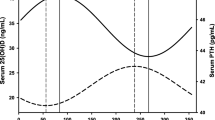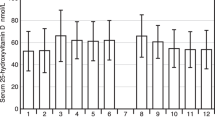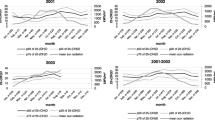Abstract
Summary
We measured serum vitamin D in 8024 Romanian subjects and found a marked seasonal variation with highest levels in September and lowest levels in March. The seasonal variation (early autumn vs. early spring) persisted in all age and sex groups. The prevalence of vitamin D deficiency was very high.
Purpose
Romania is located in Eastern Europe, roughly between 44°N and 48°N latitude. Seasonal variation of serum vitamin D in Romanian subjects is unknown. We assessed the seasonal variation of 25-hydroxy vitamin D [25(OH)D] in Romanian population.
Methods
We retrieved from our endocrinology center database all 25(OH)D measurements between 2012 and 2016. We also evaluated age, sex, diagnosis, and date of blood sampling. The 25(OH)D was measured by two different chemiluminescence or electrochemiluminescence assays.
Results
There were 8024 subjects (median age 50 (37, 62); 1429 men (17.8%)) without a diagnosis of low bone mass (osteopenia or osteoporosis). The median serum 25(OH)D was 18.6 (12.7, 25.4) ng/mL. Of the subjects, 0.73, 14.4, 55.6, and 86.1% had a serum 25(OH)D level below 4, 10, 20, and 30 ng/mL, respectively. Serum 25(OH)D showed a marked seasonal variation with highest levels in September (24.1 [18.3, 30.3] ng/mL) and lowest levels in March (13.5 [9.4, 19.6] ng/mL) (p < 0.001). The seasonal variation (early autumn vs. early spring) persisted in all age and sex groups and was maximal for 21–40 years of age (26.5 (20.8, 33.1) vs. 12.9 (9.7, 17.9) ng/mL) and minimal for >65 years of age (18.6 (13.0, 27.2) vs. 12.7 (7.8, 19.7) ng/mL). Men and women showed similar amplitude of serum 25(OH)D variation.
Conclusion
The prevalence of vitamin D deficiency is high, particularly in the elderly. The data show a strong seasonal variation of serum 25(OH)D in all subgroups of our Romanian population with highest levels in September and lowest levels in March.


Similar content being viewed by others
References
Holick MF (2007) Vitamin D deficiency. N Engl J Med 357(3):266–281. https://doi.org/10.1056/NEJMra070553
Burgaz A, Akesson A, Oster A, Michaëlsson K, Wolk A (2007) Associations of diet, supplement use, and ultraviolet B radiation exposure with vitamin D status in Swedish women during winter. Am J Clin Nutr 86(5):1399–1404
Hintzpeter B, Mensink GB, Thierfelder W et al (2008) Vitamin D status and health correlates among German adults. Eur J Clin Nutr 62(9):1079–1089. https://doi.org/10.1038/sj.ejcn.1602825
Hypponen E, Power C (2007) Hypovitaminosis D in British adults at age 45 y: nationwide cohort study of dietary and lifestyle predictors. Am J Clin Nutr 85(3):860–868
Andersen R, Molgaard C, Skovgaard LT et al (2005) Teenage girls and elderly women living in northern Europe have low winter vitamin D status. Eur J Clin Nutr 59(4):533–541. https://doi.org/10.1038/sj.ejcn.1602108
van der Wielen RP, Lowik MR, van den Berg H et al (1995) Serum vitamin D concentrations among elderly people in Europe. Lancet 346(8969):207–210. https://doi.org/10.1016/S0140-6736(95)91266-5
Capatina C, Carsote M, Caragheorgheopol A, Poiana C, Berteanu M (2014) Vitamin d deficiency in postmenopausal women—biological correlates. Maedica (Buchar) 9(4):316–322
Chirita-Emandi A, Socolov D, Haivas C, Calapiș A, Gheorghiu C, Puiu M (2015) Vitamin D status: a different story in the very young versus the very old Romanian patients. PLoS One 10(5):e0128010. https://doi.org/10.1371/journal.pone.0128010
Grigorie D, Sucaliuc A, Ivan M, Neacsu E, Popa O, Diaconescu A (2008) High prevalence of vitamin D deficiency in 1048 Romanian women with postmenopausal osteoporosis. Acta Endocrinol (Buc) 4(1):33–45. https://doi.org/10.4183/aeb.2008.33
Lips P, Duong T, Oleksik A, Black D, Cummings S, Cox D, Nickelsen T (2001) A global study of vitamin D status and parathyroid function in postmenopausal women with osteoporosis: baseline data from the multiple outcomes of raloxifene evaluation clinical trial. J Clin Endocrinol Metab 86(3):1212–1221. https://doi.org/10.1210/jcem.86.3.7327
McKenna MJ (1992) Differences in vitamin D status between countries in young adults and the elderly. Am J Med 93(1):69–77. https://doi.org/10.1016/0002-9343(92)90682-2
Spiro A, Buttriss JL (2014) Vitamin D: an overview of vitamin D status and intake in Europe. Nutr Bull 39(4):322–350. https://doi.org/10.1111/nbu.12108
Bhattoa HP, Nagy E, More C, Kappelmayer J, Balogh A, Kalina E, Antal-Szalmas P (2013) Prevalence and seasonal variation of hypovitaminosis D and its relationship to bone metabolism in healthy Hungarian men over 50 years of age: the HunMen Study. Osteoporos Int 24(1):179–186. https://doi.org/10.1007/s00198-012-1920-2
Bhattoa HP, Bettembuk P, Ganacharya S, Balogh A (2004) Prevalence and seasonal variation of hypovitaminosis D and its relationship to bone metabolism in community dwelling postmenopausal Hungarian women. Osteoporos Int 15(6):447–451. https://doi.org/10.1007/s00198-003-1566-1
Merlo C, Trummler M, Essig S, Zeller A (2015) Vitamin D deficiency in unselected patients from Swiss primary care: a cross-sectional study in two seasons. PLoS One 10(9):e0138613. https://doi.org/10.1371/journal.pone.0138613
Papapetrou PD, Triantaphyllopoulou M, Karga H, Zagarelos P, Aloumanis K, Kostakioti E, Vaiopoulos G (2007) Vitamin D deficiency in the elderly in Athens, Greece. J Bone Miner Metab 25(3):198–203. https://doi.org/10.1007/s00774-006-0746-4
Mezquita-Raya P, Munoz-Torres M, Luna JD et al (2001) Relation between vitamin D insufficiency, bone density, and bone metabolism in healthy postmenopausal women. J Bone Miner Res 16(8):1408–1415. https://doi.org/10.1359/jbmr.2001.16.8.1408
Holick MF, Chen TC, Lu Z, Sauter E (2007) Vitamin D and skin physiology: a D-lightful story. J Bone Miner Res 22(Suppl 2):V28–V33. https://doi.org/10.1359/jbmr.07s211
Atli T, Gullu S, Uysal AR, Erdogan G (2005) The prevalence of vitamin D deficiency and effects of ultraviolet light on vitamin D levels in elderly Turkish population. Arch Gerontol Geriatr 40(1):53–60. https://doi.org/10.1016/j.archger.2004.05.006
Gannage-Yared MH, Chemali R, Yaacoub N et al (2000) Hypovitaminosis D in a sunny country: relation to lifestyle and bone markers. J Bone Miner Res 15(9):1856–1862. https://doi.org/10.1359/jbmr.2000.15.9.1856
El-Hajj Fuleihan G, Nabulsi M, Choucair M et al (2001) Hypovitaminosis D in healthy schoolchildren. Pediatrics 107(4):E53. https://doi.org/10.1542/peds.107.4.e53
Krieg MA, Cornuz J, Jacquet AF, Thiébaud D, Burckhardt P (1998) Influence of anthropometric parameters and biochemical markers of bone metabolism on quantitative ultrasound of bone in the institutionalized elderly. Osteoporos Int 8(2):115–120. https://doi.org/10.1007/BF02672506
Semba RD, Houston DK, Bandinelli S, Sun K, Cherubini A, Cappola AR, Guralnik JM, Ferrucci L (2010) Relationship of 25-hydroxyvitamin D with all-cause and cardiovascular disease mortality in older community-dwelling adults. Eur J Clin Nutr 64(2):203–209. https://doi.org/10.1038/ejcn.2009.140
Tolppanen AM, Fraser A, Fraser WD, Lawlor DA (2012) Risk factors for variation in 25-hydroxyvitamin D(3) and D(2) concentrations and vitamin D deficiency in children. J Clin Endocrinol Metab 97(4):1202–1210. https://doi.org/10.1210/jc.2011-2516
Lagunova Z, Porojnicu AC, Lindberg F, Hexeberg S, Moan J (2009) The dependency of vitamin D status on body mass index, gender, age and season. Anticancer Res 29(9):3713–3720
Wortsman J, Matsuoka LY, Chen TC, Lu Z, Holick MF (2000) Decreased bioavailability of vitamin D in obesity. Am J Clin Nutr 72(3):690–693
Lester E, Skinner RK, Wills MR (1977) Seasonal variation in serum-25-hydroxyvitamin-D in the elderly in Britain. Lancet 1(8019):979–980
MacLaughlin J, Holick MF (1985) Aging decreases the capacity of human skin to produce vitamin D3. J Clin Invest 76(4):1536–1538. https://doi.org/10.1172/JCI112134
Author information
Authors and Affiliations
Corresponding author
Ethics declarations
Conflicts of interest
None.
Electronic supplementary material
ESM 1
Serum 25(OH)D concentration by month in 8024 subjects without a diagnosis of low bone mass (white bars) and 6028 subjects with a diagnosis of low bone mass (gray bars). The boxes represent the median (25, 75 percentile). The whiskers and small squares below and above represent 10th and 90th percentiles and 5th and 95th percentiles respectively. (GIF 39 kb)
ESM 2
Serum 25(OH)D concentration by age group and month in winter and spring (top panel) or summer and autumn (lower panel). White bars = 0–10 years; gray bars = 11–20 years; rightwards dashed gray bars = 21–40 years; leftwards dashed gray bars = 41–65 years; dotted bars= > 65 years of age (GIF 46 kb)
(GIF 47 kb)
Rights and permissions
About this article
Cite this article
Niculescu, D.A., Capatina, C.A.M., Dusceac, R. et al. Seasonal variation of serum vitamin D levels in Romania. Arch Osteoporos 12, 113 (2017). https://doi.org/10.1007/s11657-017-0407-3
Received:
Accepted:
Published:
DOI: https://doi.org/10.1007/s11657-017-0407-3




